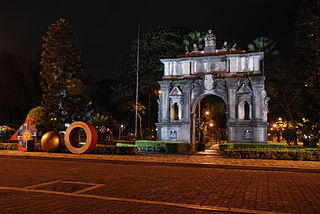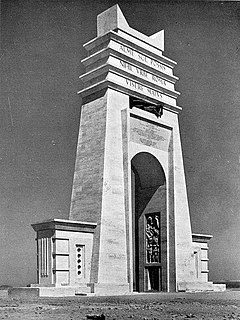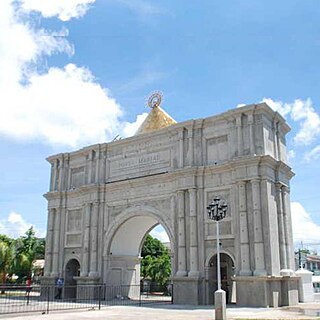 W
WThe concatenation (enchainement) is an architectural composition that unites chaining parts together—as with separate elements in long façades, with the fronts being brought forward or recessed.
 W
WA triumphal arch is a monumental structure in the shape of an archway with one or more arched passageways, often designed to span a road. In its simplest form a triumphal arch consists of two massive piers connected by an arch, crowned with a flat entablature or attic on which a statue might be mounted or which bears commemorative inscriptions. The main structure is often decorated with carvings, sculpted reliefs, and dedications. More elaborate triumphal arches may have multiple archways.
 W
WThe Arch of the Centuries is a triumphal arch at the Plaza Intramuros of the University of Santo Tomas (UST) in Manila, in the Philippines that stands meters away from the university's Millennium Gate along España Boulevard. Half of the current structure, the side facing the UST Main Building is the ruins of the original Intramuros arch while the side that faces España Boulevard is a replica. The arch was formerly the original entrance to the university when the campus was still in Intramuros during the years from 1680 to 1941. It was declared by the National Museum as a National Cultural Treasure on January 25, 2010.
 W
WThe Arco Británico is a monument on Avenida Brasil, in Valparaíso, Chile. It was donated to the town in 1910 by the British community there to mark the centenary of the Independence of Chile. Designed by the Chilean architect Alfredo Azancot, the arch was unveiled in 1911.
 W
WThe Flag Square, Plaza de la Bandera in Spanish, is the biggest monument dedicated to the Flag of Dominican Republic, is located in one of the busiest areas of the city of Santo Domingo, at the intersection of the Avenues February 27 and Gregorio Luperon. It is a patriotic monument seeks to pay tribute to one of the most important national symbols of the nation.
 W
WFusiliers' Arch is a monument which forms part of the Grafton Street entrance to St Stephen's Green park, in Dublin, Ireland. Erected in 1907, it was dedicated to the officers, non-commissioned officers and enlisted men of the Royal Dublin Fusiliers who fought and died in the Second Boer War (1899–1902).
 W
WThe Independence Arch in Accra, Ghana, is part of the Independence Square which contains monuments to Ghana's independence struggle, including the Independence Arch, Black Star Gate, and the Liberation Day Monument.
 W
WThe Ljubljanica Sluice Gate, or the Partition, is a sluice gate and a triumphal arch on the Ljubljanica River in Ljubljana, the capital of Slovenia. It is located between Cukrarna and Vraz Square in the Center District, east of the Ljubljana old town, a bit downstream of Ambrož Square. It was designed in 1939 by the Slovene architect Jože Plečnik, who envisaged it as a monumental farewell to the Ljubljanica River on its exit from the Ljubljana city centre. It was planned to be used as a footbridge as well. The sluice gate was built with difficulty from 1940 until 1943 by the constructor Matko Curk. Since July 2009, it has been protected as a monument of national significance, along with other major works by Plečnik.
 W
WThe Marble Arch, also Arch of the Philaeni, formerly known in Libya as El Gaus, was a monument in Libya built during the days of Italian colonization. The arch marked the border between Tripolitania and Cyrenaica, and was located on the Via Balbia near Ra's Lanuf.
 W
WPorta Macedonia is a triumphal arch located on Pella Square in Skopje, North Macedonia. Construction started in 2011 and was completed in January 2012.
 W
WThe Porta Mariae is a triumphal arch in Naga City commemorating the tercentenary of the devotion to Our Lady of Peñafrancia.
 W
WThe Propylaea is a city gate in Munich at the west side of Königsplatz.
 W
WThe Arch of Triumph is a triumphal arch in Pyongyang, North Korea. It was built to commemorate the Korean resistance to Japan from 1925 to 1945. It is the second tallest triumphal arch in the world, after Monumento a la Revolución in Mexico, standing 60 m (197 ft) high and 50 m (164 ft) wide.
 W
WThe Sabhyata Dwar or Civilization Gate is a sandstone arch monument located on the banks on River Ganga in the city of Patna in the Indian state of Bihar. The Sabhyata Dwar is built with a Mauryan-style architecture with a purpose to show the ancient glory of Pataliputra and traditions and culture of the state of Bihar. The monument was first envisioned by the former Lieutenant General Srinivas Kumar Sinha. The 32 metres (105 ft) high structure is taller than Gateway of India by 6 metres (20 ft) and was built at a cost of ₹ 5 crore. The monument is spread over an area of one acre within the campus of Samrat Ashok International Convention Centre. The arches of the Dwar contain inscriptions attributed to Megasthenes, Ashoka, Buddha and Mahavira. Bihar Chief Minister Nitish Kumar inaugurated the monument on 21 May 2018.
 W
WThe Triumphal Arc was built in 1781 for the visit of Polish King Stanisław August Poniatowski to the historic city of Kamianets-Podilskyi in Khmelnytskyi Oblast (province) of western Ukraine. The arc was designed in the late Baroque style by city masters, and has survived till this day without any reconstructions. Restorations, have, however been conducted on the arc, in 1947-1948 and during the mid-1980s.
 W
WThe Triumphal Arch is a 16th-century monumental woodcut print commissioned by the Holy Roman Emperor Maximilian I. The composite image was printed on 36 large sheets of paper from 195 separate wood blocks. At 295 × 357 centimetres (116 × 141 in), it is one of the largest prints ever produced and was intended to be pasted to walls in city halls or the palaces of princes. It is a part of a series of three huge prints created for Maximilian, the others being a Triumphal Procession which is led by a Large Triumphal Carriage ; only the Arch was completed in Maximilian's lifetime and distributed as propaganda, as he intended. Together, this series has been described by art historian Hyatt Mayor as "Maximilian's program of paper grandeur". They stand alongside two published biographical allegories in verse, the Theuerdank and Weisskunig, heavily illustrated with woodcuts.
 W
WThe Triumphal Arch is one of the best known sights in the Austrian city of Innsbruck. It is located at the southern end of the present Maria-Theresien-Straße, once the southern road out of the city.
 W
WThe Victory Arch, officially known as the Swords of Qādisīyah، and popularly called the Hands of Victory or the Crossed Swords, are a pair of triumphal arches in central Baghdad, Iraq. Each arch consists of a pair of outstretched hands holding crossed swords. The two arches mark the two entrances to Grand Festivities Square and the parade ground constructed to commemorate the Iran–Iraq War, led by then Iraqi President Saddam Hussein. The arches were opened to the public on 8 August 1989. It is one of Baghdad's visitor attractions and near to The Monument to the Unknown Soldier.
 W
WThe Waterpoort is a triumphal arch located in the Zuiderdokken, Zuid Antwerp. The monument was originally a water gate on the Scheldt river.